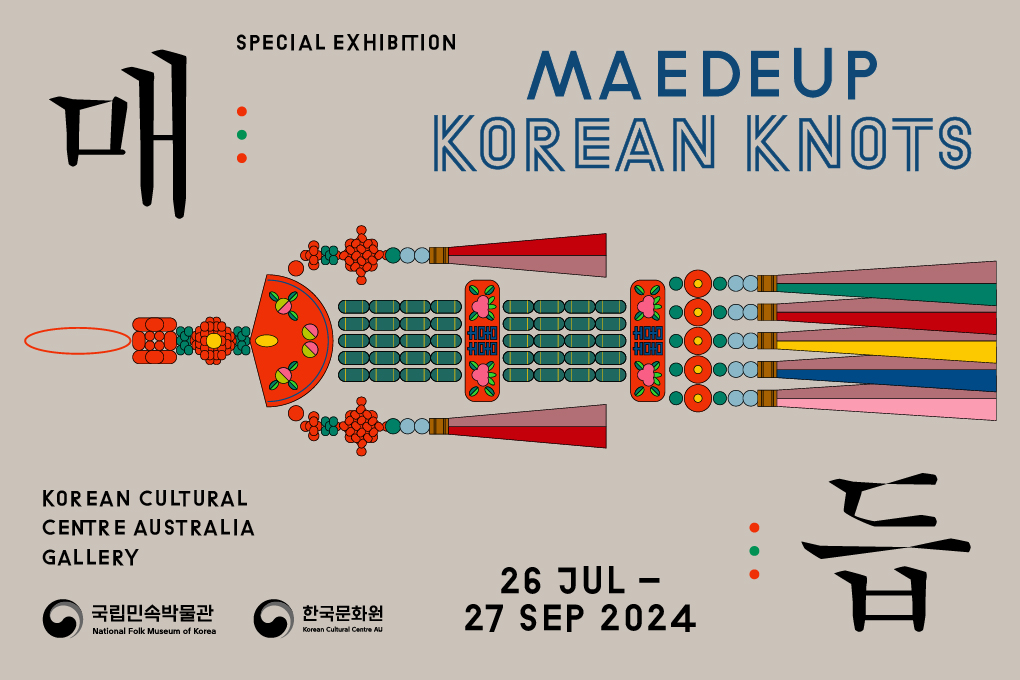
The Korean Cultural Centre Australia and the National Folk Museum of Korea present a special exhibition, Maedeup, Korean knots.
The centrepiece of the exhibition is Maedeup, Korean knots, a testament to the country’s rich cultural history. From the delicate beauty of traditional hanbok accessories to intricate adornments for ceremonial purposes, each knot tells a story of cultural contexts that shaped the evolution of maedeup, tracing its journey from humble practical fastenings to its elevated status as a revered art form.
Maedeup explores to discover the intricate techniques employed by master artisans, from the fundamental elements of knot construction to the symbolic meanings woven into each design.
What is Maedeup
Maedeup is created by hand-knotting and tightening plaited cords (kkeunmok or dahoe), which have also been made by twisting yarns together by hand. Often forming part of a larger object, maedeup is the shining, supporting character that enhances the dignity of the main character.
Maedeup have always been presented in the lives of Koreans and can be seen in clothing and accessories, furniture, household items, and ceremonial or royal courts items.
History of the Korean Maedeup
The history of Korea’s maedeup dates back to the ancient Goguryeo Kingdom (37 BCE-668 CE). A tomb wall painting from 357 CE depicts the deceased individual during their lifetime, showing maedeup on the belt around his waist and on various surrounding banners.
Maedeup were extensively utilised during the Goryeo (918-1392) and Joseon (1392-1910) periods for both ceremonial purposes and the decoration of everyday objects. Notably, the Joseon royal family employed numerous splendid maedeup decorations to assert their authority and majesty. Various craftsmen were assigned specific roles in the production of these royal knot ornaments. Individual artisans specialised in processes such as boiling the silk threads, combining the threads to achieve uniform thickness, dyeing the threads, interweaving the threads into dahoe (plaited cords), and tying maedeup with them.
During the Joseon era, artisans were not the only ones who produced maedeup. Senior ladies-in-waiting (sanggung) at the palace also plaited dahoe and tied maedeup with them, while womenfolk outside the palaces produced and used such silk cords and decorative knots on their own.
However, as the 20th century progressed, Koreans increasingly embraced Western-style clothing, leading to a decline in demand for dahoe and maedeup, which were primarily used to decorate traditional belts, pouches, and norigae (traditional decorative pendants). Furthermore, the introduction of machines for plaiting dahoe disrupted the generational transmission of cord plaiting skills. Conversely, the decorative knots, which could only be tied by hand, continued to be maintained as a craft and occupation.
Since the 1960s, the Korean government has designated individuals skilled in decorative knotting as National Intangible Heritage, allowing the tradition to be preserved and passed down. Today, these maedeup master artisans perform all the production processes, from silk thread dyeing and cord plaiting to knot tying.
Discover more from the brochure (TBC)
Maedeup, Korean knots
26 July – 27 September 2024
Korean Cultural Centre Australia
Public Program
Exhibition Opening & Special Tour led by a curator from National Folk Museum of Korea
Friday, 26 July
Korean Cultural Centre Australia
Free event, Bookings essential (TBC)
The National Folk Museum of Korea, situated on the grounds of Gyeongbokgung Palace in Jongno-gu, Seoul, is a national museum that employs replicas of historical objects to depict the history of traditional Korean life.